The Three-Dimensional Analytical and Governance Logic of China’s Digital Divide Bridging Policy
Abstract
1. Introduction
2. Review and Framework
2.1. Review
2.2. Analytical Framework
2.2.1. X-Dimension: Policy Tools
2.2.2. Y-Dimension: Policy Objectives
2.2.3. Z-Dimension: Policy Effectiveness
3. Data and Methods
3.1. Samples and Data Sources
3.2. Text Analysis Method
3.3. PMC Index Model
4. Analysis and Results
4.1. Distribution and Temporal Context of the Policy Types
4.2. Analysis of the Policy Instruments
4.3. Analysis of Policy Objectives
4.4. Analysis of the Policy Effectiveness
4.5. Objective Tool Two-Dimensional Analysis
4.6. Tool Effectiveness and Goal Effectiveness Analysis
5. Conclusions
6. Recommendations
6.1. Policy Recommendations
6.2. Limitation
6.3. Prospect
Author Contributions
Funding
Institutional Review Board Statement
Informed Consent Statement
Data Availability Statement
Conflicts of Interest
References
- Xi, J. Congratulatory Letter to World Internet Conference Wuzhen Summit. Available online: http://www.gov.cn (accessed on 21 November 2022).
- Tong, X.; Wang, L. An empirical study on college students’ online ticket Purchasing: Taking 12306 System of Ministry of Transport as an example. E-Government 2013, 100–108. [Google Scholar] [CrossRef]
- Liang, M. Singapore’s experience and inspiration in promoting “Internet plus government Services”. E-Government 2017, 11, 48–54. [Google Scholar]
- Yang, B.; Jin, D. The digital divide of the aged: Expression form, motivation exploration and bridging path. Acad. J. Zhongzhou 2021, 12, 74–80. [Google Scholar]
- Xue, E.Y.; Fu, W.Q.; Li, J. On the fairness of online education development. China Educ. Technol. 2021, 3, 1–7+70. [Google Scholar]
- China Internet Network Information Center. The 50th Statistical Report on Internet Development in China. 2022. Available online: http://www.cnnic.net.cn/ (accessed on 21 November 2022).
- World Development Report 2016: Digital Dividends. 2016. Available online: https://www.worldbank.org/en/publication/wdr2016 (accessed on 21 November 2022).
- Kong, W.; Wu, J.; Huang, S. Digital divide and relative deprivation: Micro evidence and mechanisms of influence. E-Government 2021, 1, 110–124. [Google Scholar]
- Wen, J.; Hussain, H.; Jiang, R.; Waheed, J. Overcoming the Digital Divide with ICT Diffusion: Multivariate and Spatial Analysis at China’s Provincial Level. Sage Open 2023, 13. [Google Scholar] [CrossRef]
- Li, L.; Jin, G.Z.; Guo, Y.L.; Jing, R. Internet access, support, usage divides, and depressive symptoms among older adults in China: A nationally representative cross-sectional study. J Affect. Disord. 2023, 323, 514–523. [Google Scholar] [CrossRef]
- Qadikolaei, M.R.; Zali, N.; Soltani, A. Spatiotemporal investigation of the digital divide, the case study of Iranian Provinces. Env. Dev. Sustain. 2022, 1–16. [Google Scholar] [CrossRef]
- Vicente, M.R. ICT for healthy and active aging: The elderly as first and last movers. Telecommun. Policy 2022, 46, 102262. [Google Scholar] [CrossRef]
- Vassilakopoulou, P.; Hustad, E. Bridging Digital Divides: A Literature Review and Research Agenda for Information Systems Research. Inf. Syst. Front. 2021, 1–15. [Google Scholar] [CrossRef]
- Wei, K.; Teo, H.; Chan, H.C.; Tan, B.C.Y. Conceptualizing and Testing a Social Cognitive Model of the Digital Divide. Inf. Syst. Res. 2011, 22, 170–187. [Google Scholar] [CrossRef]
- Burtch, G.; Chan, J. Investigating the Relationship between Medical Crowdfunding and Personal Bankruptcy in the United States: Evidence of a Digital Divide. MIS Quart 2019, 43, 237. [Google Scholar] [CrossRef]
- Hsieh, J.; Rai, A.; Keil, M. Addressing Digital Inequality for the Socioeconomically Disadvantaged Through Government Initiatives: Forms of Capital that Affect ICT Utilization. Inf. Syst. Res. 2011, 22, 233–253. [Google Scholar] [CrossRef]
- Chang, S.I.; Yen, D.C.; Chang, I.C.; Chou, J.-C. Study of the digital divide evaluation model for government agencies—A Taiwanese local government’s perspective. Inf. Syst. Res. 2012, 14, 693–709. [Google Scholar] [CrossRef]
- Dewan, S.; Ganley, D.; Kraemer, K.L. Complementarities in the Diffusion of Personal Computers and the Internet: Implications for the Global Digital Divide. Inf. Syst. Res. 2010, 21, 925–940. [Google Scholar] [CrossRef]
- Niehaves, B.; Plattfaut, R. Internet adoption by the elderly: Employing is technology acceptance theories for understanding the age-related digital divide. Eur. Inf. Syst. Res. 2014, 23, 708–726. [Google Scholar] [CrossRef]
- Ono, H.; Zavodny, M. Digital inequality: A five country comparison using microdata. Soc. Sci. Res. 2007, 36, 1135–1155. [Google Scholar] [CrossRef]
- Mumporeze, N.; Prieler, M. Gender digital divide in Rwanda: A qualitative analysis of socioeconomic factors. Telemat. Inf. 2017, 34, 1285–1293. [Google Scholar] [CrossRef]
- Picatoste, X.; Mesquita, A.; Gonzalez-Laxe, F. Gender wage gap, quality of earnings and gender digital divide in the European context. Empirica 2023, 50, 301–321. [Google Scholar] [CrossRef]
- Vicente, M.R.; Lopez, A.J. Assessing the regional digital divide across the European Union-27. Telecommun. Policy 2011, 35, 220–237. [Google Scholar] [CrossRef]
- Billon, M.; Ezcurra, R.; Lera-Lopez, F. The spatial distribution of the internet in the European Union: Does geographical proximity matter? Eur. Plan Stud. 2008, 16, 119–142. [Google Scholar] [CrossRef]
- Jauhiainen, J.S.; Eyvazlu, D.; Junnila, J.; Virnes, A. Digital divides, the Internet and social media uses among Afghans in Iran. Technol. Soc. 2022, 70, 102057. [Google Scholar] [CrossRef]
- Zillien, N.; Hargittai, E. Digital Distinction: Status-Specific Types of Internet Usage. Soc. Sci. Quart 2009, 90, 274–291. [Google Scholar] [CrossRef]
- Robison, K.K.; Crenshaw, E.M. Reevaluating the Global Digital Divide: Socio-Demographic and Conflict Barriers to the Internet Revolution. Sociol. Inq. 2010, 80, 34–62. [Google Scholar] [CrossRef]
- Robinson, L.; Cotten, S.R.; Ono, H.; Quan-Haase, A.; Mesch, G.; Chen, W.; Schulz, J.; Hale, T.M.; Stern, M.J. Digital inequalities and why they matter. Inf. Commun. Soc 2015, 18, 569–582. [Google Scholar] [CrossRef]
- Abdelfattah, B.M.; Bagchi, K.; Udo, G.; Kirs, P. Understanding the Internet Digital Divide: An Exploratory Multi-Nation Individual-Level Analysis. AMCIS Proc. 2010, 542. Available online: http://aisel.aisnet.org/amcis2010/542 (accessed on 22 November 2022).
- Falling through the Net: Defining the Digital Divide. 1999. Available online: http://spamcon.org/library/NTIA/FTTN.pdf (accessed on 22 November 2022).
- Van Dijk, J. The Deepening Divide: Inequality in the Information Society; Sage Publications Inc.: Thousand Oaks, CA, USA, 2005. [Google Scholar]
- Bonfadelli, H. The Internet and Knowledge Gaps: A Theoretical and Empirical Investigation. Eur. J. Commun. 2002, 17, 65–84. [Google Scholar] [CrossRef]
- Bucy, E.P. Social Access to the Internet. Harv. Int. J. Press/Politics 2000, 5, 50–61. [Google Scholar] [CrossRef]
- OECD. Understanding the Digital Divide. 2001. Available online: https://www.oecd-ilibrary.org/science-and-technology/understanding-the-digital-divide_236405667766 (accessed on 22 November 2022).
- Dewan, S.; Frederick, J.R. The Digital Divide: Current and Future Research Directions. J. Assoc. Inf. Syst. 2005, 6, 298–336. [Google Scholar]
- Wenz, A.; Keusch, F. The second-level smartphone divide: A typology of smartphone use based on frequency of use, skills, and types of activities. Mob. Media Commun. 2022. [Google Scholar] [CrossRef]
- Gunkel, D.J. Second Thoughts: Toward a Critique of the Digital Divide. New Media Soc. 2003, 5, 499–522. [Google Scholar] [CrossRef]
- van Deursen, A.J.A.M.; van der Zeeuw, A.; de Boer, P.; Jansen, G.; van Rompay, T. Digital inequalities in the Internet of Things: Differences in attitudes, material access, skills, and usage. Inf. Commun. Soc. 2021, 24, 258–276. [Google Scholar] [CrossRef]
- Morrison, B.A.; Nicholson, J.; Wood, B.; Briggs, P. Life after lockdown: The experiences of older adults in a contactless digital world. Front. Psychol. 2023, 13, 8363. [Google Scholar] [CrossRef]
- Dutton, W.H.; Reisdorf, B.C. Cultural divides and digital inequalities: Attitudes shaping Internet and social media divides. Inf. Commun. Soc. 2018, 22, 18–38. [Google Scholar] [CrossRef]
- Gonzales, A. The contemporary US digital divide: From initial access to technology maintenance. Inf. Commun. Soc. 2016, 19, 234–248. [Google Scholar] [CrossRef]
- Barzilai-Nahon, K. Gaps and Bits: Conceptualizing Measurements for Digital Divide/s. Inf. Soc. 2006, 22, 269–278. [Google Scholar] [CrossRef]
- Lorraine, M.M. 2009 Presidential Address: Repositioning Politics in Education’s Circle of Knowledge. Educ. Res. 2009, 38, 417–427. [Google Scholar]
- Chen, M.; Zhou, Y. New progress in digital inequality research. Econ. Perspect. 2022, 4, 123–139. [Google Scholar]
- Lal, B.; Dwivedi, Y.K.; Rana, N.P.; Frost, D.; Chirara, S. Understanding ‘Development’ from the Perspective of E-Government, Digital Divide and ICT4D Literature: A Research Agenda. In Proceedings of the 19th Annual International Conference on Digital Government Research: Governance in the Data Age; Association for Computing Machinery: New York, NY, USA, 2018; pp. 413–418. [Google Scholar]
- Hua, Z.; Ling, W.; Xu, N. Digital Divide or Digital Dividend?—The impact of digital technology use on the income of low-income rural households. J. China Agric. Univ. Soc. Sci. 2022, 39, 133–154. [Google Scholar] [CrossRef]
- Li, W.; Zhou, D.; Li, X. The impact and mechanism of digital Divide on rural household income: An empirical analysis based on China Household Tracking Survey (CFPS) data. J. Southwest Minzu Univ. Humanit. Soc. Sci. 2022, 43, 116–127. [Google Scholar]
- Huang, M.; Dou, X. Will the digital divide between urban and rural areas hinder the upgrading of rural residents’ consumption structure?—Based on China Household Tracking Survey (CFPS) data. Inq. Econ. Issues 2022, 9, 47–64. [Google Scholar]
- Kang, J.; Li, J. The influence of digital divide on the quality of rural basic education in Southwest minority areas and its countermeasures. Guizhou Ethn. Stud. 2022, 43, 193–198. [Google Scholar] [CrossRef]
- Li, Q.; Han, Q. Digital Divide and Household Wealth Gap: An Empirical Test based on CHFS data. J. Yunnan Univ. Financ. Econ. 2021, 37, 80–96. [Google Scholar] [CrossRef]
- Sayaf, A.M.; Alamri, M.M.; Alqahtani, M.A.; Alrahmi, W.M. Factors Influencing University Students’ Adoption of Digital Learning Technology in Teaching and Learning. Sustainability 2022, 14, 493. [Google Scholar] [CrossRef]
- Lei, Z. Validity, temperature and scale of digital governance. Gov. Stud. 2021, 37, 5–16. [Google Scholar] [CrossRef]
- Huo, P.; Ying, H. The theoretical basis, action logic and practical Path of bridging the digital divide between urban and rural areas—Based on the analysis of “Network Action Plan for Poverty Alleviation”. J. China Agric. Univ. Soc. Sci. 2022, 39, 183–196. [Google Scholar] [CrossRef]
- Du, Y.; Cao, L.; Tan, C. How does platformization help manufacturing enterprises to cross the digital divide of transformation and upgrading?—An exploratory case study based on Zongshen Group. J. Manag. World 2022, 38, 117–139. [Google Scholar] [CrossRef]
- Shumin, W. Bridging the Global Digital Divide: What to do with international Law. J. Political Sci. Law 2021, 6, 3–15. [Google Scholar]
- Ge, X.; Zhang, L. The Reason of “New Digital Gap” for urban and rural teachers and the way to bridge it—From the theoretical perspective of “Knowledge Gap”. J. South China Norm. Univ. Soc. Sci. Ed. 2021, 4, 42–51. [Google Scholar]
- Jamil, S. From digital divide to digital inclusion: Challenges for wide-ranging digitalization in Pakistan. Telecommun. Policy 2021, 45, 102206. [Google Scholar] [CrossRef]
- Chen, Z. Public Policy Analysis; China Renmin University Press: Beijing, China, 2003; ISBN 7-300-04986-9. [Google Scholar]
- Rui, W. Quantitative evaluation of China’s Policy to stabilize foreign trade and foreign investment in an uncertain environment: Based on an analysis of 73 policy texts from 2018 to 2022. Adm. Trib. 2022, 29, 75–81. [Google Scholar]
- Henry, N. Public Administration and Public Affairs; Prentice Hall: Hoboken, NJ, USA, 2007; ISBN 978-7-300-14380-4. [Google Scholar]
- Chunfu, W. Policy Network and realization mechanism of public policy Effectiveness. J. Manag. World 2006, 9, 137–138. [Google Scholar]
- Rothwell, R. Reindustrialization and technology: Towards a national policy framework. Sci. Public Policy 1985, 12, 113–130. [Google Scholar] [CrossRef]
- Van Dijk, J.; Hacker, K. The Digital Divide as a Complex and Dynamic Phenomenon. Inf. Soc. 2003, 19, 315–326. [Google Scholar] [CrossRef]
- Van Dijk, J. A Framework for Digital Divide Research. Electron. J. Commun. 2002, 12, 1–2. [Google Scholar]
- Venkatesh, V.; Morris, M.G.; Davis, G.B.; Davis, F.D. User Acceptance of Information Technology: Toward a Unified View. MIS Quart 2003, 27, 425–478. [Google Scholar] [CrossRef]
- Reisdorf, B.C.; Groselj, D. Internet (non-)use types and motivational access: Implications for digital inequalities research. New Media Soc. 2015, 19, 1157–1176. [Google Scholar] [CrossRef]
- Van Deursen, A.J.A.M.; Mossberger, K. Any Thing for Anyone? A New Digital Divide in Internet-of-Things Skills. Policy Internet 2018, 10, 122–140. [Google Scholar] [CrossRef]
- Blank, G.; Groselj, D. Dimensions of Internet use: Amount, variety, and types. Inf. Commun. Soc. 2014, 17, 417–435. [Google Scholar] [CrossRef]
- Ruiz Estrada, M.A. Policy modeling: Definition, classification and evaluation. J. Policy Model. 2011, 33, 523–536. [Google Scholar] [CrossRef]
- Ruiz Estrada, M.A.; Yap, S.F.; Nagaraj, S. Beyond the Ceteris Paribus Assumption: Modeling Demand and Supply Assuming Omnia Mobilis. Int. J. Econ. Res. 2008, 5, 185–194. [Google Scholar]
- Thorsrud, L.A. Words are the New Numbers: A Newsy Coincident Index of the Business Cycle. J. Bus. Econ. Stat. 2020, 38, 393–409. [Google Scholar] [CrossRef]
- Baker, S.R.; Bloom, N.; Davis, S.J. Measuring Economic Policy Uncertainty. Q. J. Econ. 2016, 131, 1593–1636. [Google Scholar] [CrossRef]
- Fan, Z.; Shi, W. Research on information equity in the 21st Century: Context, Structure and Prospect. Doc. Inf. Knowl. 2023, 40, 137–150. [Google Scholar]
- Yang, S.U. Hidden digital divide and its governance. J. Xi’an Univ. Financ. Econ. 2023, 36, 41–56. [Google Scholar] [CrossRef]
- Silva, D.S.; Yamashita, G.H.; Cortimiglia, M.N.; Brust-Renck, P.G.; Caten, C.S.T. Are we ready to assess digital readiness? Exploring digital implications for social progress from the Network Readiness Index. Technol. Soc. 2022, 68, 101875. [Google Scholar] [CrossRef]
- Wang, L.; Liu, C. Critical evaluation of China’s universal service policy: Toward a harmonious online nation. Inf. Soc. 2021, 37, 177–189. [Google Scholar] [CrossRef]
- Liu, C.; Wang, L. Does national broadband plan narrow regional digital divide? Evidence from China. Chin. J. Commun. 2019, 12, 449–466. [Google Scholar] [CrossRef]
- Lixia, F. The system logic and standardization of the Party—Government joint document. Chin. J. Law 2021, 43, 3–19. [Google Scholar]
- Fang, M.L.; Canham, S.L.; Battersby, L.; Sixsmith, J.; Wada, M.; Sixsmith, A. Exploring Privilege in the Digital Divide: Implications for Theory, Policy, and Practice. Gerontologist 2019, 59, E1–E15. [Google Scholar] [CrossRef]
- Korovkin, V.; Park, A.; Kaganer, E. Towards conceptualization and quantification of the digital divide. Inf. Commun. Soc. 2022, 1–36. [Google Scholar] [CrossRef]
- Da Silva, A.; Teixeira, A.A.; Cavalcanti, T. The Digital Divide and the Smart Digital Governance in Brazil: Tensions between the Skills of Multiple Policy Areas and the Needs of Society. In Proceedings of the 14th International Conference on Theory and Practice of Electronic Governance, Athens, Greece, 6–8 October 2021; Loukis, E., Macadar, M.A., Nielsen, M.M., Eds.; Association for Computing Machinery: New York, NY, USA, 2021; pp. 129–135. [Google Scholar]
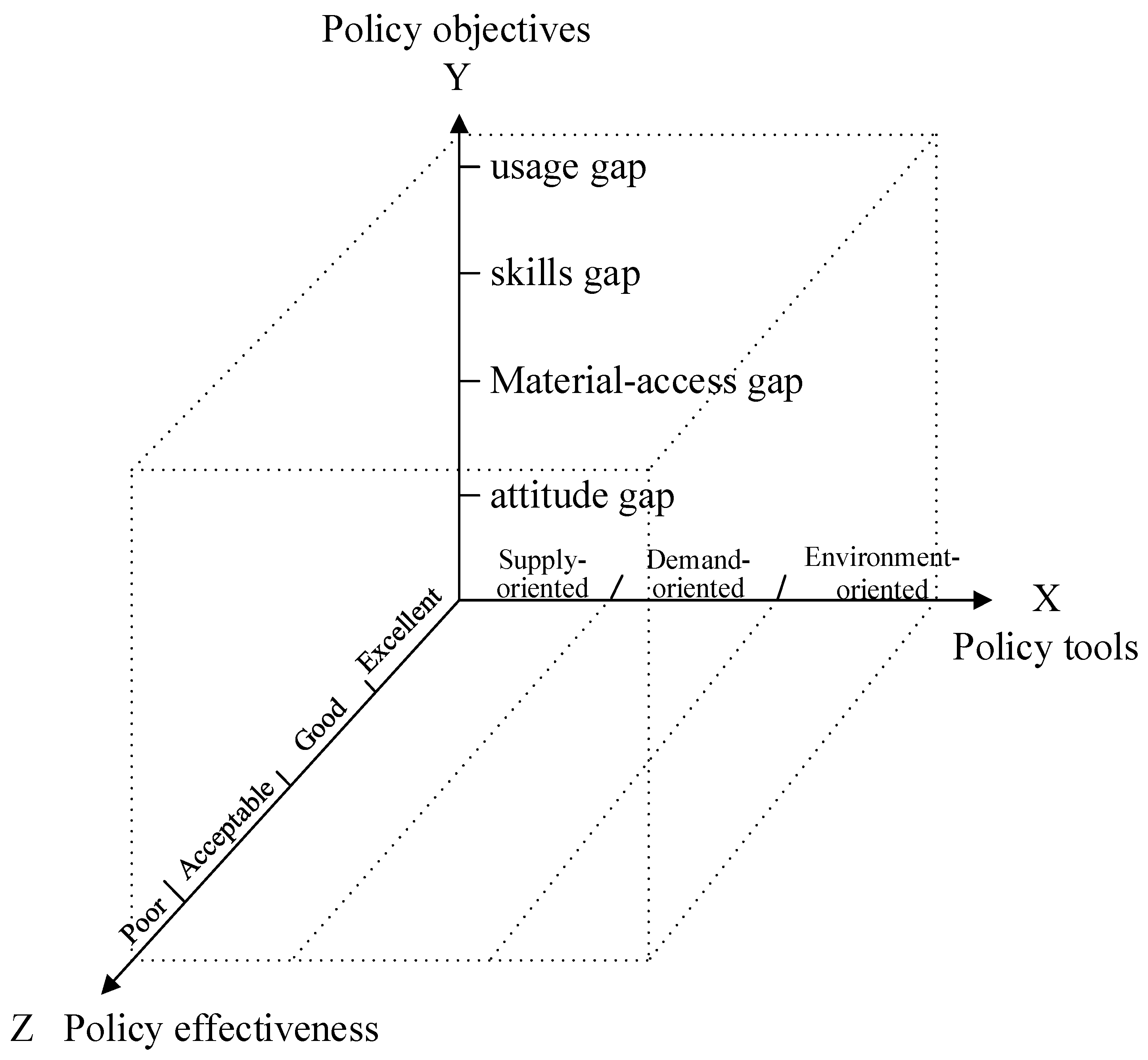

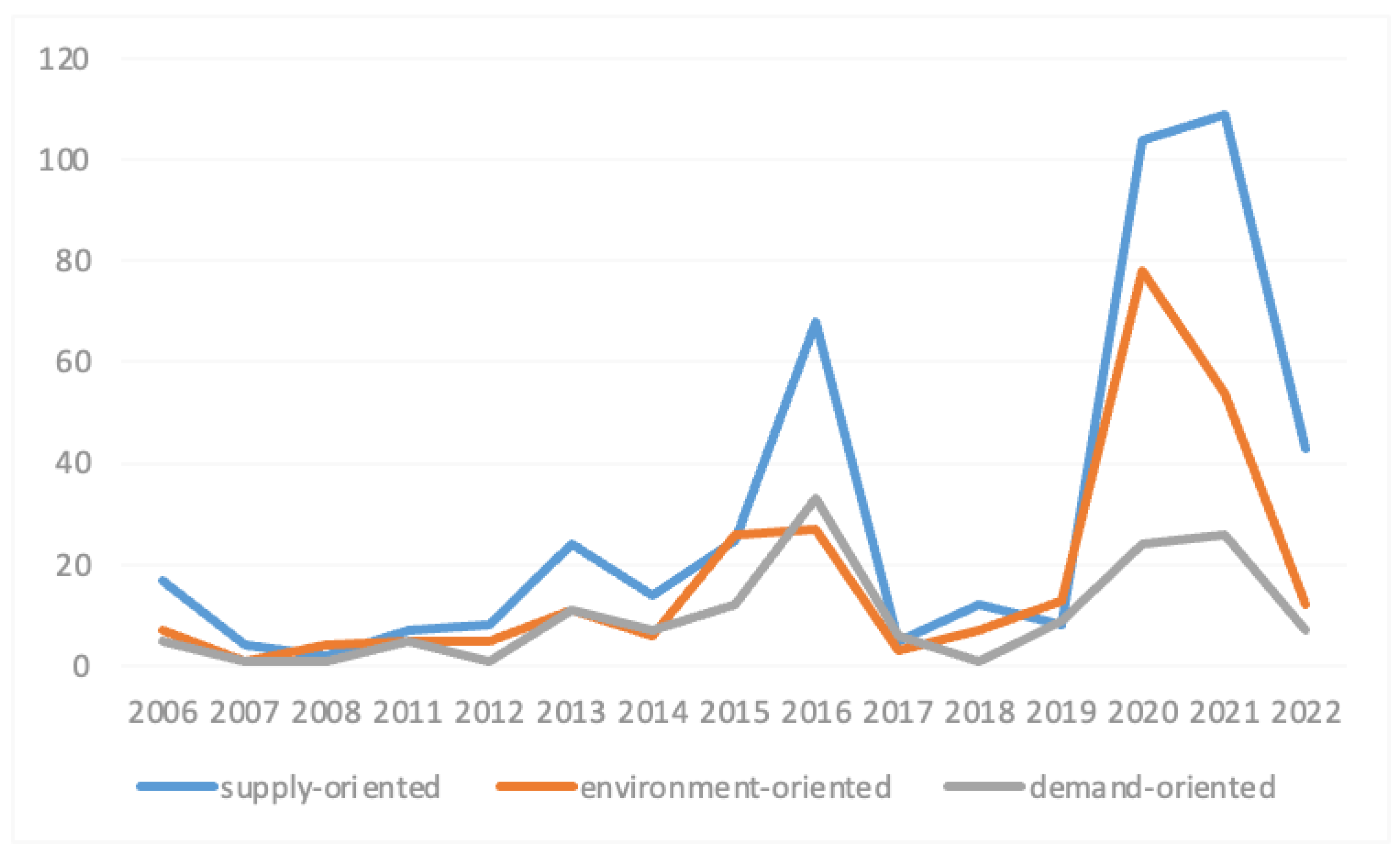

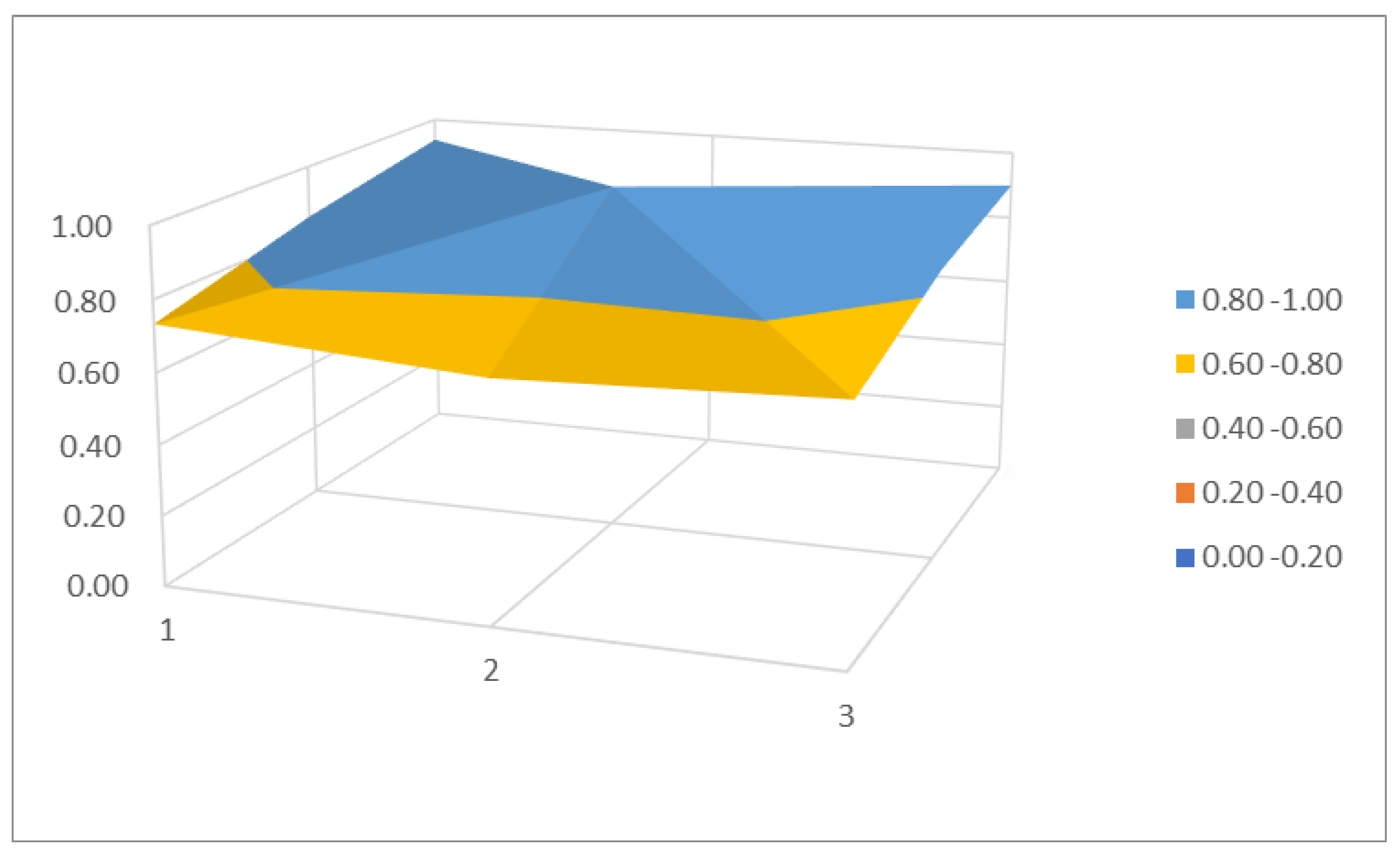
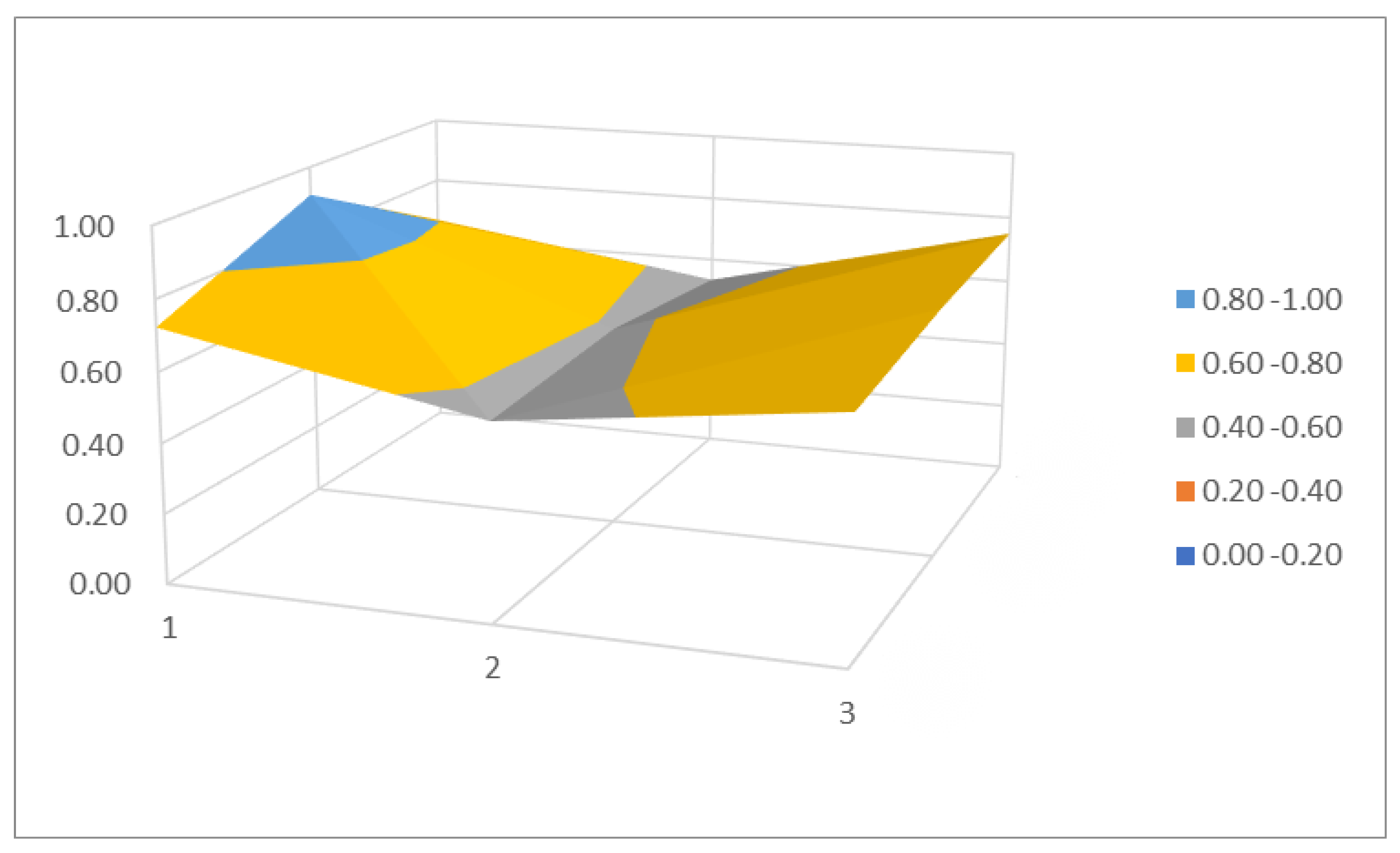
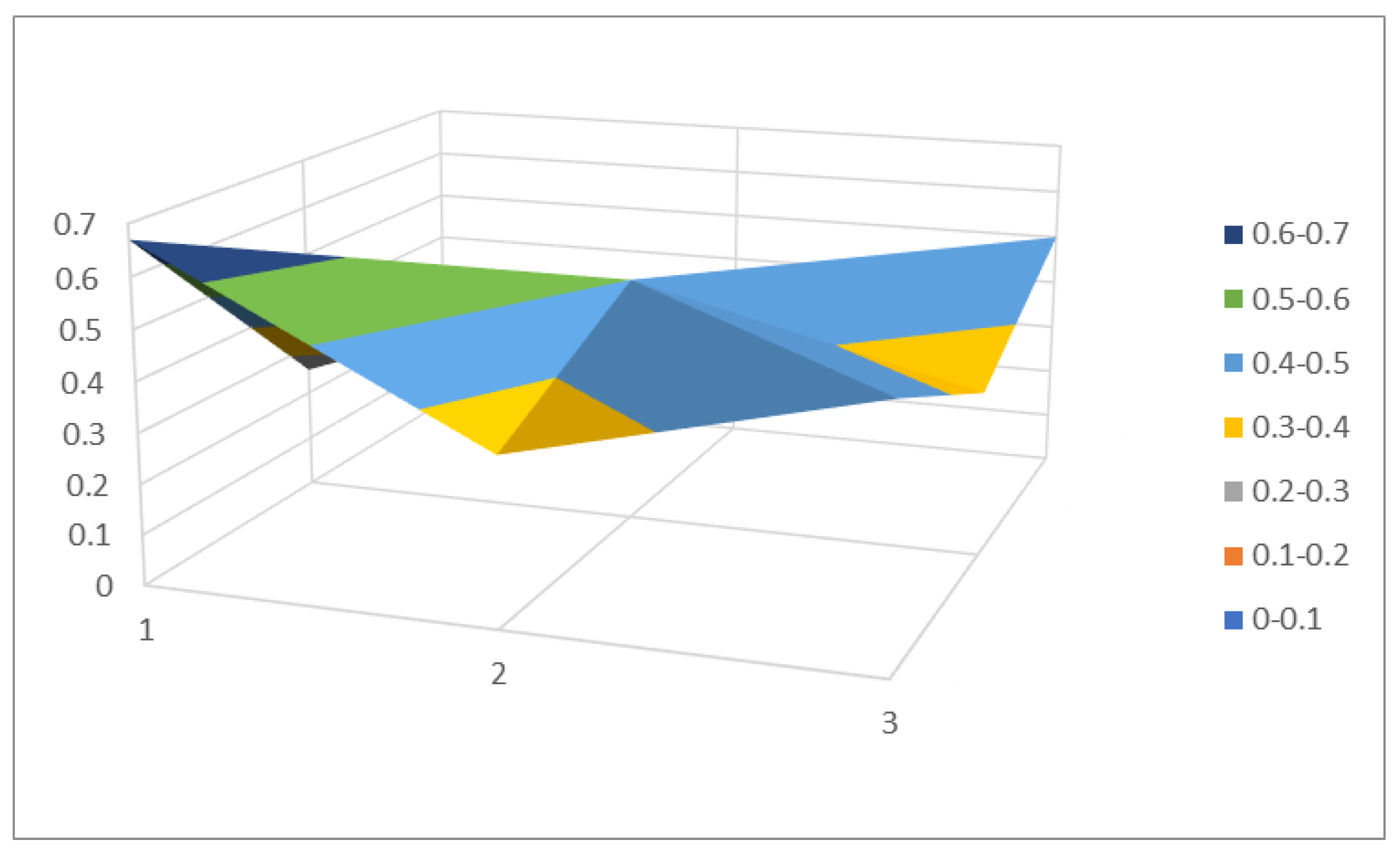
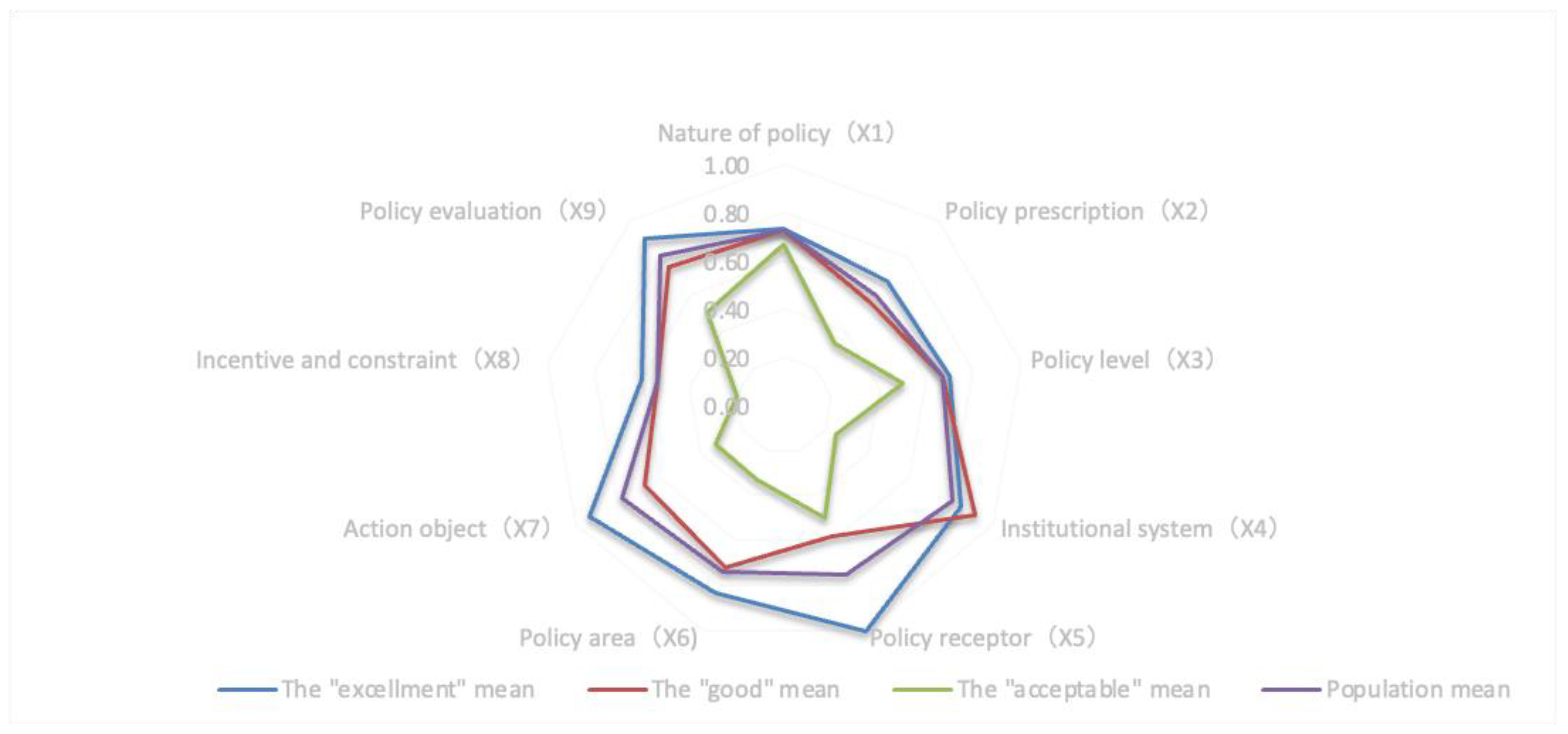

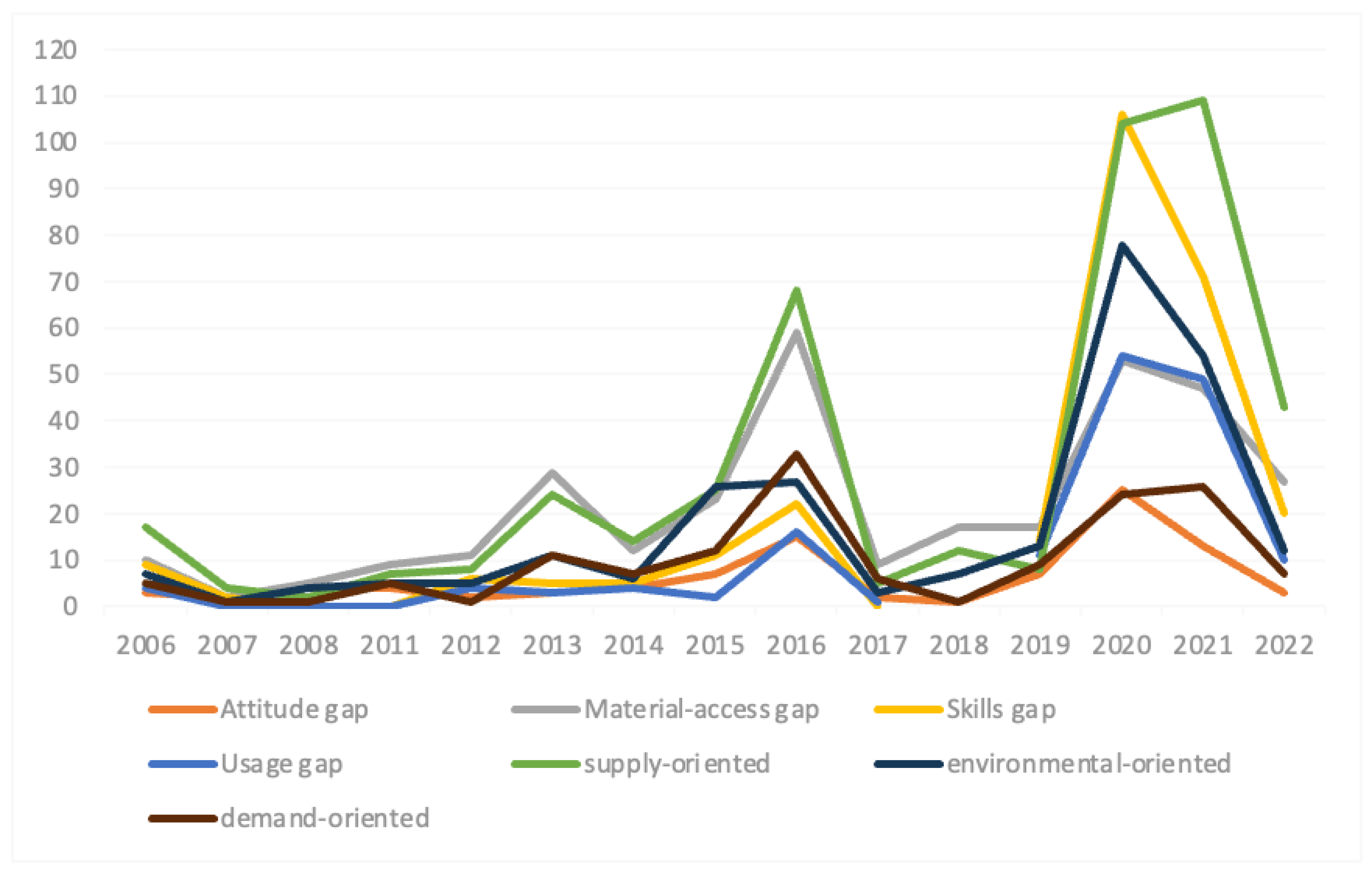
| Types | Secondary Policy Instrument | Specific Meaning |
|---|---|---|
| Supply-oriented policy tools | Product support | Design and update products suitable for vulnerable groups to meet the needs of customers. |
| Public services | Improve public services in medical, health, education, culture and elderly care. | |
| Infrastructure construction | Provide basic security through internet access and building infrastructure. | |
| Education and training | Provide intellectual and technical support through skills training, education and teaching. | |
| Scientific and technological support | Utilize key technologies such as artificial intelligence, 5G, Internet of Things, big data, edge computing and blockchain. | |
| Talent training | Intensify the training of practitioners, improve the quality of volunteers and strengthen the construction of digital talent. | |
| Demonstration projects | Through pilot and demonstration projects, digital development is promoted on a point-by-point basis. | |
| Financial support | Provide financial support through financial input or expanding the scale of the budget. | |
| Environment-oriented policy tools | Standard design | Strengthen the formulation of standards for the Internet of Things, big data, e-government and information services for digital development. |
| Regulatory control | Create an orderly development environment by improving laws and regulations and strengthening supervision. | |
| Preferential rates | Tax breaks and other preferential policies are given to participants in bridging the digital divide. | |
| Financial support | Foster a sound financial environment through financing, loans and deregulation. | |
| Supervision and assessment | Establish an evaluation mechanism to ensure the implementation of policies. | |
| Target planning | Have clear goals, responsibilities and tasks to bridge the digital divide. | |
| Policy support | Strengthen the supervision and regulation of behaviors by formulating policies, rules and regulations. | |
| Organizational construction | Strengthen the function of an organization, coordination and leadership and fulfill work responsibilities. | |
| Strategic measures | In addition to the abovementioned categories, these include other measures to bridge the digital divide. | |
| Demand-oriented policy tools | Enrichment of channels | Develop digital service channels for digital demand. |
| Public–private cooperation | Ensure the role of private enterprises and private capital to effectively promote the development of digital equality. | |
| Cost reduction | Improve the mechanism for compensating universal telecommunications services, lower internet charges for poor households and bolster digital demand. | |
| Exchange and cooperation | Encourage exchanges and cooperation, draw on relevant mature practices and bridge the digital divide. | |
| Residents’ needs | Support the people’s demand for a better digital life. | |
| Market cultivation | Stimulate social digital demand through market shaping, consumption promotion and e-commerce platform cultivation. | |
| Construction | Build a digital China, integrate urban and rural development and provide equal access to public services. |
| Number | Title | Time | Publishing Department | Administrative Level |
|---|---|---|---|---|
| 1 | Measures for the Implementation of the Knowledge Renewal Project for Information Professionals (“Project 653”) | 2006 | Personnel Department; Ministry of information Industry | Departmental regulations |
| 2 | Notice on the issuance of the National Strategy for Informatization Development 2006–2020 | 2006 | General Office of the CPC Central Committee; General Office of The State Council of China | Administrative regulations |
| 3 | Key Points of Communication Industry Fashion Construction in 2006 | 2006 | Ministry of information Industry | Departmental regulations |
| 4 | New Rural Construction Technology to Promote Action | 2006 | Ministry of Science and Technology | Departmental regulations |
| 5 | Opinions on Further Strengthening the Construction of Agricultural Informatization | 2006 | Ministry of Agriculture | Departmental regulations |
| 6 | Some Suggestions on the In-Depth Implementation of the Spark Plan | 2007 | Ministry of Science and Technology | Departmental regulations |
| 7 | National General Framework of Agricultural and Rural Informatization Construction (2007–2015) | 2007 | Ministry of Agriculture | Departmental regulations |
| ... | ||||
| 47 | A Circular on the Implementation Plan to Effectively Solve the Elderly’s Difficulties in Using Intelligent Technology | 2020 | General Office of The State Council | Administrative regulations |
| 48 | A Circular on Launching the “Wisdom to Help the Elderly” Campaign | 2020 | National Working Committee on Aging | Departmental regulations |
| 49 | A Circular on Further Promoting the “Internet Plus Medical and Health” and ”Five Ones” Service Actions | 2020 | The National Health Commission; National Healthcare Security Administration; NATCM | Departmental regulations |
| 50 | Announcement on Matters Related to Standardizing the Receipt and Payment of RMB Cash | 2020 | People’s Bank of China | Departmental regulations |
| ... | ||||
| 76 | Guidelines on Strengthening the Construction of Digital Government | 2022 | The State Council | Administrative regulations |
| 77 | The 14th Five-Year Plan for Cultural Development | 2022 | General Office of the CPC Central Committee; General Office of The State Council | Administrative regulations |
| 78 | A Research Report on the Implementation of the National Strategy for Actively Responding to Population Aging and Promoting High-Quality Development of Undertakings for the Elderly | 2022 | Social Development Committee of the NPC | Working papers of the NPC |
| 79 | Report on the Progress in Strengthening and Advancing the Work on Aging | 2022 | The State Council | Administrative regulations |
| 80 | Notice on Further conducted the “Excellent Teacher Plan” for Normal University Student Training | 2022 | Ministry of Education | Departmental regulations |
| 81 | Notice on the Issuance of the 14th Five-Year Plan for Informatization of National Health | 2022 | National Health Commission | Departmental regulations |
| First-Order Variable | Second-Order Variable | Second-Order Variable Evaluation |
|---|---|---|
| Nature of policy (X1) | Forecast (X1-1) | Is it predictive? Yes is 1, no is 0 |
| Suggestion (X1-2) | Does it provide comments or suggestions? Yes is 1, no is 0 | |
| Feedback (X1-3) | Is feedback reflected? Yes is 1, no is 0 | |
| Supervise (X1-4) | Does it embody supervision? Yes is 1, no is 0 | |
| Description (X1-5) | Is it descriptive? Yes is 1, no is 0 | |
| Guide (X1-6) | Does it reflect the orientation? Yes is 1, no is 0 | |
| Policy prescription (X2) | Long-term (X2-1) | Is the effect more than 5 years? Yes is 1, no is 0 |
| Metaphase (X2-2) | Is the effect 3 to 5 years? Yes is 1, no is 0 | |
| Short-term (X2-3) | Is the effect less than 3 years? Yes is 1, no is 0 | |
| Policy level (X3) | Laws and regulations (X3-1) | Does the force conform to legal and regulatory standards? Yes is 1, no is 0 |
| Administrative regulations (X3-2) | Does the force comply with industry regulations and standards? Yes is 1, no is 0 | |
| Departmental regulations (X3-3) | Does the force meet the department’s regulatory standards? Yes is 1, no is 0 | |
| Specification document (X3-4) | Does the force meet the specification document? Yes is 1, no is 0 | |
| Institutional system (X4) | Overall planning and coordination (X4-1) | Does it promote overall coordination among various bodies? Yes is 1, no is 0 |
| Platform construction (X4-2) | Does it involve digital platform construction content? Yes is 1, no is 0 | |
| Function localization (X4-3) | Does it clarify the function orientation and classification guidance of each subject? Yes is 1, no is 0 | |
| Team building (X4-4) | Does it involve building a digital service team? Yes is 1, no is 0 | |
| Policy receptor (X5) | Government (X5-1) | Does the role level involve the government? Yes is 1, no is 0 |
| Enterprises and public institutions (X5-2) | Does the function level involve enterprise units or public institutions? Yes is 1, no is 0 | |
| Group organization (X5-3) | Does the role level involve nonprofit organizations? Yes is 1, no is 0 | |
| Social public (X5-4) | Does the role level involve the public? Yes is 1, no is 0 | |
| Policy area (X6) | Medical treatment (X6-1) | Is the policy related to the medical field? Yes is 1, no is 0 |
| Education (X6-2) | Is the policy related to the field of education? Yes is 1, no is 0 | |
| Social security (X6-3) | Doe the policy involve the field of social security? Yes is 1, no is 0 | |
| Elderly care (X6-4) | Does the policy involve the field of elderly care? Yes is 1, no is 0 | |
| Traffic (X6-5) | Is the policy related to the field of transportation? Yes is 1, no is 0 | |
| Culture (X6-6) | Is the policy related to the cultural field? Yes is 1, no is 0 | |
| Action object (X7) | Age (X7-1) | Does the target involve an age difference? Yes is 1, no is 0 |
| Urban and rural areas (X7-2) | Does it involve the gap between urban and rural areas? Yes is 1, no is 0 | |
| Body function (X7-3) | Does the object of action involve a functional gap? Yes is 1, no is 0 | |
| Incentive and constraint (X8) | Financial input (X8-1) | Are financial incentives included? Yes is 1, no is 0 |
| Financial support (X8-2) | Is financial support included? Yes is 1, no is 0 | |
| Scientific and technological support (X8-3) | Does it include technology, information and product support? Yes is 1, no is 0 | |
| Regulatory control (X8-4) | Is regulatory control included? Yes is 1, no is 0 | |
| Supervision and assessment (X8-5) | Does it include supervision and assessment? Yes is 1, no is 0 | |
| Policy evaluation (X9) | Well-grounded (X9-1) | Is the policy basis sufficient? Yes is 1, no is 0 |
| Clear goal (X9-2) | Is the policy objectives clear? Yes is 1, no is 0 | |
| Detailed planning (X9-3) | Is the goal planning detailed and accurate? Yes is 1, no is 0 | |
| Program science (X9-4) | Are the measures scientific? Yes is 1, no is 0 |
| Score | 0–2.99 | 3–4.99 | 5–6.99 | 7–9 |
|---|---|---|---|---|
| Evaluation | poor | acceptable | good | excellent |
| Types of Policy Instruments | Secondary Policy Instrument | File | Reference Point | Percentage | Class Percentage |
|---|---|---|---|---|---|
| Supply-oriented policy tools | Product support | 30 | 62 | 7.23% | 52.45% |
| Public services | 39 | 104 | 12.12% | ||
| Infrastructure construction | 45 | 92 | 10.72% | ||
| Education and training | 36 | 70 | 8.16% | ||
| Scientific and technological support | 37 | 62 | 7.23% | ||
| Talent training | 7 | 7 | 0.82% | ||
| Demonstration projects | 28 | 38 | 4.43% | ||
| Financial support | 11 | 15 | 1.75% | ||
| Environment-oriented policy tools | Standard design | 8 | 11 | 1.28% | 30.19% |
| Regulatory control | 9 | 13 | 1.52% | ||
| Preferential rates | 2 | 2 | 0.23% | ||
| Financial support | 23 | 29 | 3.38% | ||
| Supervision and assessment | 5 | 5 | 0.58% | ||
| Target planning | 25 | 46 | 5.36% | ||
| Policy support | 17 | 23 | 2.68% | ||
| Organizational construction | 29 | 41 | 4.78% | ||
| Strategic measures | 45 | 89 | 10.37% | ||
| Demand-oriented policy tools | Enrichment of channels | 17 | 22 | 2.56% | 17.37% |
| Public–private cooperation | 18 | 23 | 2.68% | ||
| Cost reduction | 14 | 18 | 2.10% | ||
| Exchange and cooperation | 19 | 27 | 3.15% | ||
| Residents’ needs | 11 | 14 | 1.63% | ||
| Market cultivation | 12 | 25 | 2.91% | ||
| Construction | 12 | 20 | 2.33% |
| Policy Number | 1 | 2 | 45 | 46 | 47 | 69 | 76 | 78 | 79 | |
|---|---|---|---|---|---|---|---|---|---|---|
| First-Order Variable | ||||||||||
| Nature of policy (X1) | 0.67 | 0.67 | 0.67 | 0.83 | 0.67 | 0.83 | 0.83 | 0.67 | 0.67 | |
| Policy prescription (X2) | 0.33 | 0.33 | 0.67 | 0.67 | 0.33 | 0.67 | 1 | 0.67 | 0.67 | |
| Policy level (X3) | 0.5 | 0.5 | 0.5 | 0.75 | 0.75 | 0.75 | 0.75 | 0.75 | 0.75 | |
| Institutional system (X4) | 0.25 | 1 | 1 | 0.5 | 0.75 | 1 | 1 | 0.75 | 1 | |
| Policy receptor (X5) | 0.5 | 0.5 | 1 | 1 | 0.5 | 1 | 0.75 | 1 | 1 | |
| Policy area (X6) | 0.33 | 0.83 | 0.83 | 1 | 0.83 | 0.67 | 0.5 | 0.83 | 0.83 | |
| Action object (X7) | 0.33 | 1 | 1 | 1 | 0.33 | 0.67 | 0.67 | 1 | 1 | |
| Incentive and constraint (X8) | 0.2 | 0.2 | 0.6 | 0.4 | 0.8 | 0.8 | 0.6 | 0.6 | 0.6 | |
| Policy evaluation (X9) | 0.5 | 0.5 | 1 | 1 | 1 | 1 | 0.75 | 0.75 | 0.75 | |
| PMC index | 3.61 | 5.53 | 7.27 | 7.15 | 5.96 | 7.39 | 6.85 | 7.02 | 7.27 | |
| Sag index | 5.39 | 3.47 | 1.73 | 1.85 | 3.04 | 1.61 | 2.15 | 1.98 | 1.73 | |
| Effectiveness evaluation | acceptable | good | excellent | excellent | good | excellent | good | excellent | excellent | |
| Policy Effectiveness | Policy Tool | Policy Goal | |||||
|---|---|---|---|---|---|---|---|
| Supply Oriented | Demand Oriented | Environment Oriented | Attitude | Material | Skills | Usage | |
| Excellent | 7.30 | 2.88 | 4.25 | 1.40 | 4.78 | 3.83 | 2.88 |
| Good | 5.11 | 1.44 | 3.29 | 1.20 | 3.85 | 3.75 | 1.33 |
| Acceptable | 2.58 | 0.3 | 0.72 | 0.63 | 2.96 | 1.5 | 1.07 |
Disclaimer/Publisher’s Note: The statements, opinions and data contained in all publications are solely those of the individual author(s) and contributor(s) and not of MDPI and/or the editor(s). MDPI and/or the editor(s) disclaim responsibility for any injury to people or property resulting from any ideas, methods, instructions or products referred to in the content. |
© 2023 by the authors. Licensee MDPI, Basel, Switzerland. This article is an open access article distributed under the terms and conditions of the Creative Commons Attribution (CC BY) license (https://creativecommons.org/licenses/by/4.0/).
Share and Cite
Qi, M.; Zhang, B.; Li, J.; Liu, B. The Three-Dimensional Analytical and Governance Logic of China’s Digital Divide Bridging Policy. Sustainability 2023, 15, 7220. https://doi.org/10.3390/su15097220
Qi M, Zhang B, Li J, Liu B. The Three-Dimensional Analytical and Governance Logic of China’s Digital Divide Bridging Policy. Sustainability. 2023; 15(9):7220. https://doi.org/10.3390/su15097220
Chicago/Turabian StyleQi, Meng, Bei Zhang, Junjie Li, and Bangfan Liu. 2023. "The Three-Dimensional Analytical and Governance Logic of China’s Digital Divide Bridging Policy" Sustainability 15, no. 9: 7220. https://doi.org/10.3390/su15097220
APA StyleQi, M., Zhang, B., Li, J., & Liu, B. (2023). The Three-Dimensional Analytical and Governance Logic of China’s Digital Divide Bridging Policy. Sustainability, 15(9), 7220. https://doi.org/10.3390/su15097220





